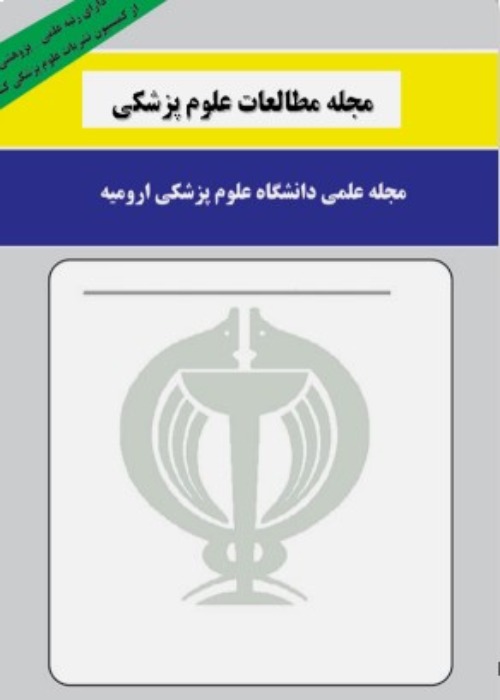EVALUATION OF ANTIBIOTIC RESISTANCE PATTERNS IN PATIENTS ADMITTED TO INTENSIVE CARE UNITS OF IMAM KHOMEINI TEACHING HOSPITALS, URMIA
Author(s):
Article Type:
Research/Original Article (دارای رتبه معتبر)
Abstract:
Background & Aim</span>:</span> The increasing prevalence of antibiotic resistance is a major health problem. The present study was designed and implemented to evaluate antibiotic resistance patterns in the patients admitted to Intensive Care Units of Imam Khomeini hospital in Urmia from September 2020 to September 2021.</span></span></span></span></span>
Material & Methods</span>:</span> In this descriptive-cross-sectional study that was conducted from September 2020 to September 2021, all cell cultures of blood, urine, sputum and respiratory secretions, cerebrospinal fluid (CSF), synovial fluid, and peritoneal fluid of the patients admitted to the ICU of Imam Khomeini Hospital in Urmia were analyzed by a complete counting method.</span></span></span></span></span>
the descriptive cross-sectional study over September 2020 till September 2021, through systemic sampling, all bacterial cultures of blood, urine, sputum and respiratory secretions, cerebrospinal fluid, synovial fluid, peritoneal fluid of the patients admitted in the ICU of imam Khomeini hospital were evaluated. Statistical analysis was conducted by SPSS 22. The significance level in this study was considered less than 0.05.</span></span></span></span></span>
Results</span>:</span> In this study, a total of 1862 culture mediums were examined, of which 1162 mediums (62.4%) had negative cultures. Also, in 348 mediums (18.60%), there were mixed fungi or bacteria. Also, 22 samples were excluded from the study due to incomplete antibiogram reporting. Finally, 330 mediums were examined with the specific result of the type of bacteria grown to check microbial resistance. The most common microorganisms isolated from urine, blood, and sputum cultures were Escherichia coli, Klebsiella, and Acinetobacter, respectively. Out of 34 mediums belonging to Staphylococcus aureus, one case was resistant to methicillin and three cases were resistant to cephalexin. Out of 252 mediums belonging to Gram-negative bacteria, ESBL, MDR, PDR and XDR were present in 61.5%, 88.1%, 34.5% and 11.5%, respectively. Antibiogram was used in 314 cases (98.5%) and did not match in 16 cases (1.5%).</span></span></span></span></span>
Conclusion</span>:</span> The present study shows the risk of increasing microbial resistance, exposure to treatment-resistant strains, and the risk of non-response to antibiotic treatment in the patients. Therefore, necessary managements should be taken to prevent the unreasonable prescription of antibiotics and the intensification of the resistance process.</span></span></span></span></span>
Material & Methods</span>:</span> In this descriptive-cross-sectional study that was conducted from September 2020 to September 2021, all cell cultures of blood, urine, sputum and respiratory secretions, cerebrospinal fluid (CSF), synovial fluid, and peritoneal fluid of the patients admitted to the ICU of Imam Khomeini Hospital in Urmia were analyzed by a complete counting method.</span></span></span></span></span>
the descriptive cross-sectional study over September 2020 till September 2021, through systemic sampling, all bacterial cultures of blood, urine, sputum and respiratory secretions, cerebrospinal fluid, synovial fluid, peritoneal fluid of the patients admitted in the ICU of imam Khomeini hospital were evaluated. Statistical analysis was conducted by SPSS 22. The significance level in this study was considered less than 0.05.</span></span></span></span></span>
Results</span>:</span> In this study, a total of 1862 culture mediums were examined, of which 1162 mediums (62.4%) had negative cultures. Also, in 348 mediums (18.60%), there were mixed fungi or bacteria. Also, 22 samples were excluded from the study due to incomplete antibiogram reporting. Finally, 330 mediums were examined with the specific result of the type of bacteria grown to check microbial resistance. The most common microorganisms isolated from urine, blood, and sputum cultures were Escherichia coli, Klebsiella, and Acinetobacter, respectively. Out of 34 mediums belonging to Staphylococcus aureus, one case was resistant to methicillin and three cases were resistant to cephalexin. Out of 252 mediums belonging to Gram-negative bacteria, ESBL, MDR, PDR and XDR were present in 61.5%, 88.1%, 34.5% and 11.5%, respectively. Antibiogram was used in 314 cases (98.5%) and did not match in 16 cases (1.5%).</span></span></span></span></span>
Conclusion</span>:</span> The present study shows the risk of increasing microbial resistance, exposure to treatment-resistant strains, and the risk of non-response to antibiotic treatment in the patients. Therefore, necessary managements should be taken to prevent the unreasonable prescription of antibiotics and the intensification of the resistance process.</span></span></span></span></span>
Keywords:
Language:
Persian
Published:
Journal of Medical Science Studies, Volume:34 Issue: 10, 2023
Pages:
651 to 660
magiran.com/p2684254
دانلود و مطالعه متن این مقاله با یکی از روشهای زیر امکان پذیر است:
اشتراک شخصی
با عضویت و پرداخت آنلاین حق اشتراک یکساله به مبلغ 1,390,000ريال میتوانید 70 عنوان مطلب دانلود کنید!
اشتراک سازمانی
به کتابخانه دانشگاه یا محل کار خود پیشنهاد کنید تا اشتراک سازمانی این پایگاه را برای دسترسی نامحدود همه کاربران به متن مطالب تهیه نمایند!
توجه!
- حق عضویت دریافتی صرف حمایت از نشریات عضو و نگهداری، تکمیل و توسعه مگیران میشود.
- پرداخت حق اشتراک و دانلود مقالات اجازه بازنشر آن در سایر رسانههای چاپی و دیجیتال را به کاربر نمیدهد.
In order to view content subscription is required
Personal subscription
Subscribe magiran.com for 70 € euros via PayPal and download 70 articles during a year.
Organization subscription
Please contact us to subscribe your university or library for unlimited access!


